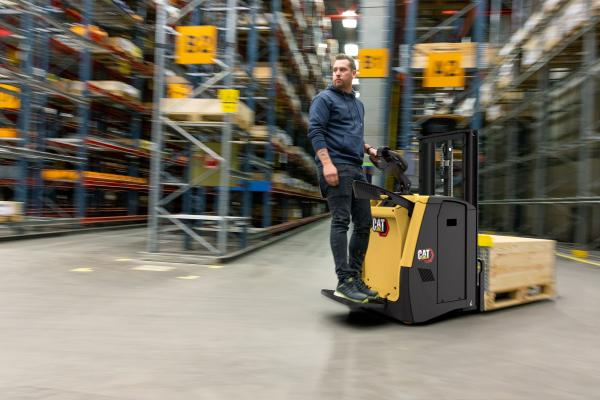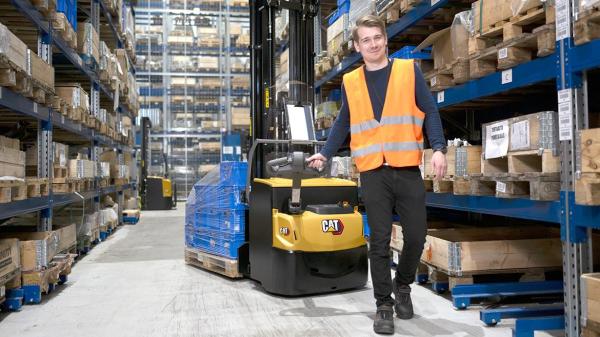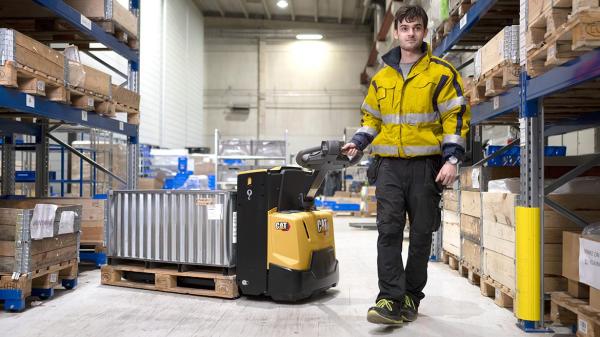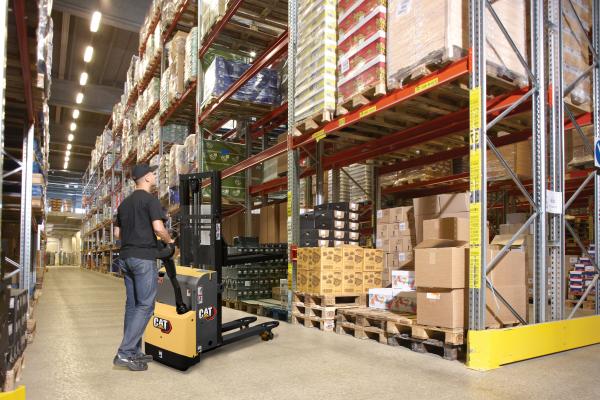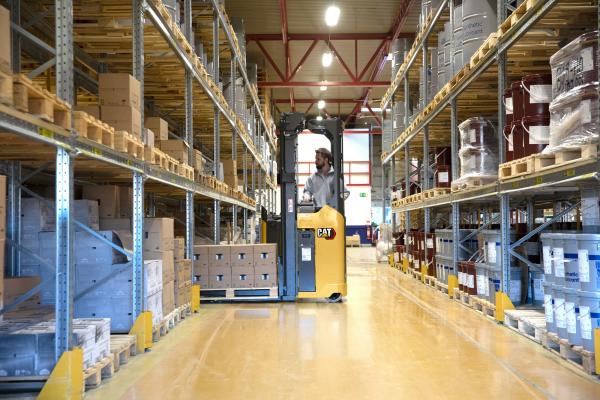As fuel and electricity prices soar, the incentive to reduce energy consumption grows ever stronger. For businesses using forklifts, Cat® Lift Trucks offers the following suggestions. Some may be obvious; others may not have been explored by your company yet. As well as saving money, each contributes to tackling carbon emissions and climate change – so everyone’s a winner.
Energy used by your warehouse and other buildings
Insulate your premises to keep expensively generated heat inside in winter. Keep windows and doors closed. Loading bays are a major escape route for heat. This can be blocked by specialist suppliers of insulating and climate-controlling doors, seals and shelters for loading docks.
In summer, try to minimise the energy you use to cool things down. If it’s cooler outside, open your windows and doors. If it’s hotter outside, close them. Use blinds to stop windows and skylights from turning your building into a greenhouse. Consider fitting high-volume, low-speed (HVLS) fans, which enhance ventilation at a relatively low energy cost. They also even out the distribution of warm air in winter, which makes heating more effective and economical.
A good rule for most electrical equipment is to switch it off completely, rather than using standby mode, when it’s not needed.
Make full use of daylight before turning on electric lights. Extra windows, skylights and solar tubes are just a few ways of grabbing more light. If you do switch on a light, turn it off when you no longer need it.
Automatic aids to reducing waste of light energy begin with simple devices which switch lights on when someone enters a room. They then switch off when no further motion is detected. More complex, intelligent systems can adjust the amount of artificial lighting according to the levels of daylight in each area. Automated switching can additionally be applied to heating, ventilation and air conditioning.
If upgrading of your lighting system is a possibility, LED is usually considered to be the most energy-efficient option. The initial investment can be repaid quickly through lower electricity bills, as case studies show.
Maintaining light levels and comfortable temperatures is much less important if the only workers in a room are machines. Full automation may not be on your agenda, but you might at least consider introducing a conveyor. That could reduce the distances travelled, and energy consumed, by your lift trucks. One option might be a conveyor for moving produce into and out of a refrigerated area. An added benefit is that the doorway can be made much smaller and easier to insulate.
It makes sense to monitor and meter the energy use of different areas, machines and processes in your facility. This will help to identify the issues needing most attention. You may also find you can save by shifting some activities to times when unit electricity costs are lower.
And how about capturing some of your energy from the environment rather than paying a power supplier for it? Warehouse and factory roofs are great places to fit large arrays of solar panels. These may be solar photovoltaic, to generate electricity, or solar thermal, to supply heat to your hot water system. Wind turbines may be another option. Air-source or ground-source heat pumps are also becoming popular.
If you’re generating your own electricity via sun or wind power, you should also look at battery energy storage systems (BESS). These will store the excess energy produced on hot or windy days, for later use.
Energy used by your materials handling equipment
How can you cut the energy consumption of your electric lift trucks and IC engine forklifts? One way is to drive them more slowly and smoothly. Rushing around at excessive speed results in higher energy use and component wear, which outweigh any productivity gain. Electric trucks can be programmed for a more economical pace, while all drivers should be trained to be less heavy-footed. Switching off engines when trucks are stationary saves fuel too.
Proper maintenance helps optimise energy efficiency, especially in the case of IC engines. In electrics with lead-acid batteries, correct battery servicing and care maintains energy-efficient performance. Use of poor-quality batteries and chargers is a false economy, as their efficiency is lower. Meanwhile, inferior or badly worn tyres consume more energy due to their higher rolling resistance.
When buying IC engine forklift trucks, look for the latest advances in fuel-efficient technology. Note that Cat® electric counterbalance trucks can provide similar power and efficiency to IC engine models but with advantages including versatile programmability.
In the last year or so, Cat Lift Trucks has introduced many new or upgraded electric-powered counterbalance and warehouse trucks. Importantly, all are offered with a choice between lead-acid and lithium-ion (Li-ion) battery power. The Li-ion option brings great energy efficiency benefits, as explained elsewhere. All these trucks also gain from advances in efficient AC motor technology and programming.
The Cat electric counterbalance line-up includes a 4.0 to 5.0 tonne range which is more energy efficient than any other in its class. Other Cat products with class-leading efficiency include the upgraded low-level order pickers and tow trucks.
In warehouses, efficient use of storage capacity reduces the amount of empty space being heated. Compact lift truck design and easy manoeuvrability contribute to this efficiency by allowing narrower racking aisles. The new Cat stand-in power pallet trucks and stand-in stackers meet this need particularly well. In addition, the stackers’ high-lifting capabilities enable fuller use and more complete filling of the building’s space at height.
Space-saving and energy-saving qualities can also be found in the upgraded Cat reach trucks, pedestrian stackers and pedestrian power pallet trucks. A new compact pedestrian stacker maximises efficiency in very small spaces. Another efficient approach is offered by the new Cat pedestrian double pallet handler. By carrying two pallet loads at once, it halves the number of trips and the energy consumed.
Further energy-saving information
For more advice on saving energy in warehousing and materials handling, please see our archive of sustainability articles.

